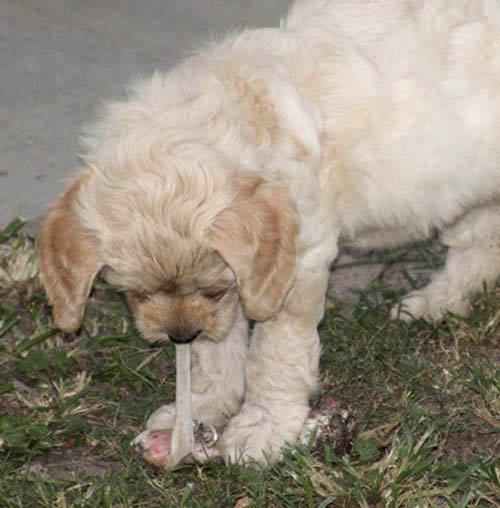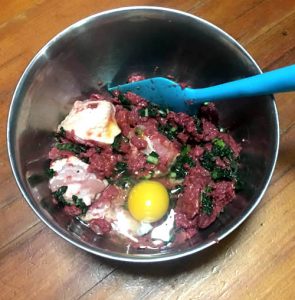

It’s pretty hard to dispute the fact that dogs LOVE bones! That same old question “what do dogs eat in the wild” gives us insight into the fact that dogs are meat-eaters and bone-eaters too, along with some raw plant produce (see our April blog for more about healthy food for your dog).
But are bones good for dogs?
Yes! Bones are great for physical, dental and mental health of your dog!
Bones provide specific nutrients and minerals from animal tissue and mineral matter, which are less available from meat. Calcium and phosphorus are mostly provided by bones from beef, pork, lamb, chicken and turkey. These minerals are critical for your dog’s development and ongoing health. Marrow contained in bigger long bones is rich in fat and blood cells.
Bigger bones are great time-occupiers, mental stimulators, and boredom-relievers, especially if a dog is alone at home! If the bones are meaty with cartilage and soft tissue still attached, they are also great teeth-cleaners, breaking down tartar and keeping gums healthy. It is said that about 90% of adult dogs suffer from gum disease, so we can all do better here dog-lovers!
So which bones are best?
There are edible bones and recreational bones.
Edible bones are bones that you feed as part of the meal so they need to have meat on them. These are the bones of birds like chicken and duck wings, drumsticks, thighs, chicken frames, kangaroo tail and turkey necks, that are soft and may be easily chopped or crushed in a grinder.
When feeding these bones with meals, the recommended ratio is 10% bone. Usually, dogs will take time to chew or break raw bones into smaller pieces that are easily digested. If your dog gulps food quickly and may swallow bigger bony pieces, then stick with chicken necks, thighs, and wings.
The puppies at Ridgy Didge have free-range chicken drumsticks from 7-8 weeks, which they just love! However, they eat the meat and leave the bones as their little teeth are not yet strong enough.
Recreational bones are the bigger beef bones with marrow inside that keep the dog occupied over some time. These are not chewed up and swallowed for meals, but are gnawed at. It is recommended that you give your dog a recreational bone at least once each week.
Don’t give these bones to your puppy until they are 10 weeks old, about a week after the pup has come home and has settled in with a simple diet to start.
A loose rule-of thumb is bones should be about the size of your dog’s head. Brisket bones cut by the butcher are really great; not too big, and lots of variety of content, and are less likely to cause teeth breakage if the chewing is aggressive!
Should I give bone supplement?
If you feed your dog 10% edible bone in their meals, do not supplement with bonemeal.
If you feed your dog only boneless meat, you will need to supplement with a good quality bone replacement. But please do your homework, there are unpleasant facts you need to be aware of:
The ground bone industry supplies the pet food industry (for dry food and bone meal supplements), and the fertilizer/garden-supply industries, among others, so demand is high, and quality regulation is poor! There is much recycling of animal waste (dead animals including unwell or medicated), use of lowest quality leftover ingredients, and cheap abundant supply from countries like China where heavy metal content exceeds safe limits.
There is a raw freeze-dried bone supplement called MCHA that is high quality and seems well-regulated. For bone-meal supplements, check that it is human grade edible bone meal, with the right calcium/phosphorus balance for your dog size and development. Also look for a heavy metal analysis to show that it is safe; reputable companies will have this as standard. Your butcher may be able to supply you with bone sawdust from his bone-saw bench.
Aren’t buried bones unhealthy?
Some dogs just love to bury bones. The putrid state of the resurrected bones may cause owners distress, so some dog-owners don’t give bones for this reason. But, resist the urge to take the bones away, before or after burial! Think back to the wild, where dogs naturally feed on abandoned and rotting carcasses! Their guts are equipped to deal with a great range of micro-organisms and that rotten bone will not make your dog sick; it’s more like a well-savoured, extra special reward!
It is worth mentioning that puppies that are regularly given bones don’t seem to bury bones so much when they are grown.
Any precautions around feeding bones?
There are some simple precautions to take around feeding bones.
- Too much bone in the diet over time will cause constipation.
- Never feed cooked bones of any type! Ever! Cooked bones can splinter and wreak havoc in the dogs gut, which means expensive vet bills or worse.
- Chicken necks have too much bone to meat ratio to satisfy your dog’s needs, and can be gulped down without much chewing. You can chop or grind them to add to more meat.
- Bones that are too small may be swallowed whole and are choking hazards.
- If your dog is a very aggressive chewer, the large recreation bones may lead to chipped or broken teeth. Be aware, and if this is likely or has happened, stick with the smaller brisket pieces.
- If you are giving bones to 2 dogs, make sure they have their own space to enjoy their bone at leisure, so there is no aggression or urgency to get rid of it quickly.
So, for a healthy and happy dog, make feeding bones part of your normal dog-care routine and watch your Cobberdog thrive!
If you would like to adopt a Ridgy Didge Australian Cobberdog, please read our Adopting a Puppy information, before you continue the adoption process. For more information, pm us on Facebook, or contact us at our website. Like and follow us on Facebook to keep up to date with ongoing puppy news and announcements.
